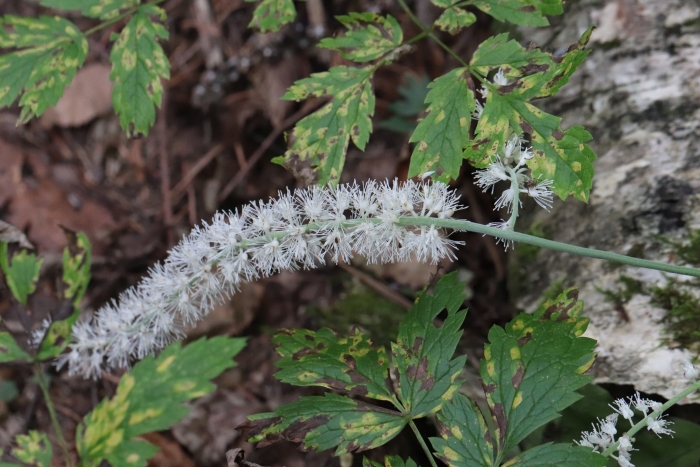Baneberry
(Actaea simplex)
Baneberry (Actaea simplex)
/
/

Nina Filippova
CC BY 4.0
Image By:
Nina Filippova
Recorded By:
Copyright:
CC BY 4.0
Copyright Notice:
Photo by: Nina Filippova | License Type: CC BY 4.0 | License URL: http://creativecommons.org/licenses/by/4.0/ | Rights Holder: Nina Filippova | Publisher: iNaturalist | Date Created: 2021-09-03T13:08:13-07:00 |






















Estimated Native Range
Summary
Actaea simplex, commonly known as baneberry or bugbane, is a clump-forming rhizomatous herbaceous perennial native to moist woodland edges, forest clearings, and shaded riverbanks in Eastern Asia. It typically grows to 1.2 meters (3.9 ft) tall by 0.6 meters (2.0 ft) wide, featuring trifoliate and pinnate basal leaves. From late summer to early fall, it produces erect or arching stems with short terminal racemes of fragrant white flowers that are particularly showy and attract pollinators. The foliage can add texture to garden settings, and the plant is valued for its late-season blooms.
Actaea simplex thrives in part shade to full shade, preferring medium-moisture, well-drained soils rich in organic matter. It is suitable for hardiness zones 4 to 8 in the US. The plant is often used in woodland gardens, shaded borders, and naturalized areas. It requires consistent moisture and should not be allowed to dry out, especially in hot, sunny conditions. While it is generally low maintenance, it can be susceptible to leaf spot and snail or slug damage. Gardeners should handle this plant with care, as all parts are highly toxic if ingested.CC BY-SA 4.0
Actaea simplex thrives in part shade to full shade, preferring medium-moisture, well-drained soils rich in organic matter. It is suitable for hardiness zones 4 to 8 in the US. The plant is often used in woodland gardens, shaded borders, and naturalized areas. It requires consistent moisture and should not be allowed to dry out, especially in hot, sunny conditions. While it is generally low maintenance, it can be susceptible to leaf spot and snail or slug damage. Gardeners should handle this plant with care, as all parts are highly toxic if ingested.CC BY-SA 4.0
Plant Description
- Plant Type: Herb
- Height: 3-4 feet
- Width: 2-3 feet
- Growth Rate: Moderate
- Flower Color: Cream, White
- Flowering Season: Summer, Fall
- Leaf Retention: Deciduous
Growth Requirements
- Sun: Part Shade, Full Shade
- Water: Medium
- Drainage: Slow, Medium, Fast
Common Uses
Bee Garden, Bird Garden, Border Plant, Butterfly Garden, Deer Resistant, Fragrant, Hummingbird Garden, Rabbit Resistant, Showy Flowers, Street Planting
Natural Habitat
native to moist woodland edges, forest clearings, and shaded riverbanks in Eastern Asia
Other Names
Common Names: Baneberry
Scientific Names: , Actaea simplex, Cimicifuga ramosa, Cimicifuga simplex, Cimicifuga simplex var. yezoensis, Cimicifuga foetida var. intermedia, Actaea yesoensis, Cimicifuga dahurica var. tschonoskii, Cimicifuga yesoensis, Cimicifuga foetida var. simplex
GBIF Accepted Name: Actaea simplex (DC.) Wormsk. ex Fisch. & C.A.Mey.